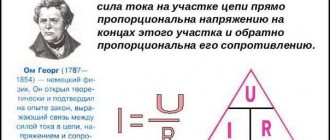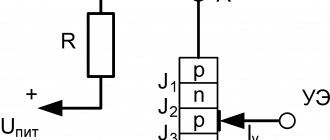Volt and Watt are units of measurement that have been known to every person since school. Since these concepts are consonant and have similar spellings, many people confuse them. In order to avoid mistakes, it is necessary to carefully study the features of each physical quantity, as well as compare them with each other. This will allow you to understand what the difference is and what factors influence it.
What are watt and volt
1 volt is equal to a unit of voltage created by an electric current at the ends of a conductive device designed to produce 1 watt of heat at a constant electrical characteristic passing through the conductor. The volt characteristic is also defined as the potential difference between two measured points when a charge of one coulomb moves from point A to point B, when work of 1 joule is required.
Volts, watts and amps
1 W is an indicator of power at which work equal to 1 J is performed per second. It turns out that W is considered a derivative of two quantities. Power and voltage have a relationship:
1W = 1V*1A
Formulas
To have an idea of what power is, you need to think logically. If we assume that it is simply force, such a conclusion will be incorrect. To correctly evaluate a physical quantity, it is enough to know that power is the rate at which a device consumes energy.
For example, a lamp can produce bright or dim light, depending on the rate at which energy is consumed. If the brightness is higher, then the consumption is higher, and vice versa.
Attention! The power rating applies to all electrical appliances, but it is not always related to electricity. This is the main difference between the indicators.
Basic current values
Power also comes in:
- Thermal – determined by temperature parameters.
- Electrical – the indicator is taken into account in electrical appliances, including light bulbs.
- Mechanical, determined by the number of horsepower.
All of the above refers to physical characteristics.
You might be interested in DRL 400 lamp
Representation of volts in other units of measurement - formulas:
Using the basic and derived SI units, the volt is expressed as follows:
B = (m² kg) / (s3 A).
B = J / Cl.
B = W / A.
B = A · Ohm.
V = (W Ohm)1/2.
where A is ampere, B is volt, C is coulomb, J is joule, m is meter, s is second, W is watt, kg is kilogram, Ohm is .
How are they designated?
W is a watt or a volt, some find it difficult to answer. The designation W was noted already in the century before last in Great Britain. The name of the measure was given in honor of the famous scientist, ideologist of the industrial revolution, James Watt, who was also the creator of the first steam engine.
He spent many years studying this indicator and used horsepower to measure it.
Volt is a unit named after the great physicist Alessandro Volta. A volt is defined as the difference in voltage or potential at the ends of a conductor, as well as between conductive sections of a circuit.
Designation of quantities:
- W – watt
- V – volt.
It is an accepted abbreviation (abbreviation) in the international system.
Examples from life
For safe operation, the voltage in the electrical outlet and the device must match. If you connect a toaster or hair dryer with a lower conductor potential, the device will burn out from overvoltage.
When the energy level in the network decreases, even a working refrigerator will produce less cold. Therefore, large household appliances are equipped with stabilizers. Thanks to these devices, the performance of the units does not decrease due to energy fluctuations.
Expert opinion
Karnaukh Ekaterina Vladimirovna
Graduated from the National University of Shipbuilding, majoring in Enterprise Economics
The more energy a device conducts, the higher its driving force. For example, the more intense the energy flow in the electrical circuit, the stronger the suction force of the vacuum cleaner.
What is the difference between W and V (V and A)
What is the difference between a volt and an ampere: Volt is a unit of measurement of voltage, and watt is a unit of power. V is the difference created in the electrical potential across a wire line when a current of 1A dissipates a unit of power, i.e. voltage. The definition of voltage is that it is the potential of electricity between different points. Along with this, it is used to indicate the difference in potential energy of an electric charge between points. An energy source is a voltage that represents expended or lost energy.
About power
Attention! Voltage is hypothetically similar to the pressure created in a circuit, pushing electrons through.
The passage of current must be ensured on two paths. This characteristic is considered the total energy for moving the charge. The definition of voltage is based on the fact that negative charges are attracted to high values, and positive charges to low values.
W – speed of work. The speed is maintained at 1 meter per second against a constant reaction force of 1 newton. If we consider it in relation to electromagnetism, the unit is the rate of work done when 1 ampere passes through a potential difference of 1V. Watt is a measure of power.
You might be interested in what power is the 16a machine designed for?
Power
Power is the energy flow with which energy is consumed. It happens that in the description of a device it appears instead of kW - kVA. To determine this value, you need to know what is measured in kVA.
No energy is expended to complete the work, but on the contrary:
- One of the factions becomes active, that is, it performs work or transforms into another form.
- The other faction is reactive. The energy is directed into an electromagnetic field.
Attention! These quantities are different, despite the same proportionality. To avoid confusion, the indicator is measured not in watts, but in volt-amperes.
Mechanical power
Definition of concepts
Volt is the term used to designate the unit of voltage in electricity. With its help, it is possible to obtain measurements that allow you to determine indicators of electrical potential, voltage, and also find out the force of electrical movement. These values appear as a result of physical transformations that occur under the influence of current at different ends of a wire or conductive device.
Watt is a term that refers to a unit of measurement of power. Watts also measure heat flux, direct electrical current power, and sound wave flux. Also, this physical unit allows you to determine power indicators related to the energy of ionizing radiation.
What voltage is measured in volts and watts
Voltage in watts or volts is measured according to individual criteria. Voltage measurements are carried out in Volts, and in the drawings it is indicated by the letter V. The voltage is measured by a device - a voltmeter. The latest devices may be:
- Analog.
- Digital.
The first ones are more accurate.
Portable devices have voltmeters built into them, and these tools are used by electricians. Analog devices are installed on electrical panels: switchboards and generators. The latest equipment comes complete with digital meters.
The voltage value in accordance with international standards is established:
- Kilovolt – kV.
- Millivolt – mV.
- Volt - V.
- Megavolt - MV.
- Microvolt - µV.
Voltage measurements
Important! Power is measured in watts (kilowatts). This value is directly proportional to the voltage, as well as to the magnitude of the current. The main difference is the designation of established indicators, according to the measurement system.
What is Current Strength. Ampere [A]
Current strength is a physical quantity equal to the ratio of the amount of charge flowing through a conductor over a certain period of time to the value of this same period of time. Measured in Amperes.
1 Ampere contains:
- 1,000,000 microamps
- 1,000 milliamps
Sometimes such a task as converting amperes to watts or kilowatts, or vice versa - watts and kilowatts to amperes, can be difficult. After all, rarely do any of us remember the formulas from school by heart. Unless, of course, you constantly have to deal with this due to your profession or hobby.
In fact, in everyday life knowledge of such things may be required quite often. For example, on the socket or plug there is a marking in the form of the inscription: “220V 6A”. This marking reflects the maximum permissible power of the connected load. What does it mean? What is the maximum power of a network device that can be plugged into such an outlet or used with this plug?
Based on this marking, we see that the operating voltage for which this device is designed is 220 volts, and the maximum current is 6 amperes. To get the power value, just multiply these two numbers: 220 * 6 = 1320 watts - the maximum power for a given plug or socket. For example, an iron with steam can only be used at two, and an oil heater can only be used at half power.
How many volts does 1 ampere contain?
It is quite difficult to answer this question. However, in order to make it easier for you to understand this issue, we suggest that you familiarize yourself with the tables of ratios
For DC
| Volts | W: A = A x Ohms = √ (W x Ohms) |
| Amps | (W : V) = √(W : Ohms) = V : Ohms |
| Ohms | B : A = W : (A)2 = (B)2 : W |
| Watts | A x B = (A)2 x Ohms = (B)2 : Ohms |
For AC
| Volts | W: (A x cos Ψ) = A x Ohms x cos Ψ = √(W x Ohms) |
| Amps | W: (V x cos Ψ) = 1/cos Ψ x √(W: Ohms) = V: (Ohms x cos Ψ) |
| Ohms | B : (A x cos Ψ) = W : (A)2 • cos2 Ψ = (B)2 : W |
| Watts | B x A x cos Ψ = (A)2 x Ohms x cos2 Ψ = (B)2 : Ohms |
How many watts are in 1 ampere?
So, to get watts, you need to multiply the indicated amperes by volts:
P = I × U
In it, P is Watt, I is A, and U is Volt. That is, multiply the current by the voltage (in the outlet we have approximately 220-230 volts). This is the main formula for finding power in single-phase electrical circuits.
An example of calculating power consumption - a washing machine consumes a current of 10 A from a 220 Volt outlet, 10 A * 220 V = 2200 W or 2.2 Kilowatts, since one Kilowatt is equal to 1000 Watts.
Converting watts to amperes
Sometimes power in watts needs to be converted to amperes. This is the problem faced, for example, by a person who decides to choose a circuit breaker for a water heater.
For example, the water heater says “2500 W” - this is the rated power at a network voltage of 220 volts. Therefore, to get the maximum amps of the water heater, we divide the rated power by the rated voltage, and we get: 2500/220 = 11.36 amps.
So, you can choose a 16 amp machine. A 10-amp circuit breaker will clearly not be enough, and a 16-amp circuit breaker will work as soon as the current exceeds the safe value. Thus, to get amperes, you need to divide the watts by the supply volts - divide the power by the voltage I = P/U (volts in a household network 220-230).
How many amperes are in a kilowatt and how many kilowatts are in an ampere
It often happens that on a network electrical appliance the power is indicated in kilowatts (kW), then it may be necessary to convert kilowatts to amperes. Since there are 1000 watts in one kilowatt, then for a mains voltage of 220 volts we can assume that there are 4.54 amperes in one kilowatt, because I = P/U = 1000/220 = 4.54 amperes. The opposite statement is also true for the network: in one ampere there are 0.22 kW, because P = I*U = 1*220 = 220 W = 0.22 kW.
For approximate calculations, it can be taken into account that with a single-phase load, the rated current I ≈ 4.5P, where P is the power consumption in kilowatts. For example, with P = 5 kW, I = 4.5 x 5 = 22.5 A.
Watts to kilowatts
That is, 1 kW = 1000 W (one kilowatt is equal to a thousand watts). The reverse translation is just as simple: you can divide the number by a thousand or move the decimal point three digits to the left. For example:
- washing machine power 2100 W = 2.1 kW;
- kitchen blender power 1.1 kW = 1100 W;
- electric motor power 0.55 kW = 550 W, etc.
Kilojoules to kilowatts and kilowatt-hours
Sometimes it's useful to know how to convert kilojoules to kilowatts. To answer this question, let's return to the basic ratio of watts and joules: 1 W = 1 J/1 s. It's easy to guess that:
- 1 kilojoule = 0.0002777777777778 kilowatt-hour (there are 60 minutes in one hour, and 60 seconds in one minute, therefore there are 3600 seconds in an hour, and 1/3600 = 0.000277778).
- 1 W = 3600 joule per hour
Watts to horsepower
- 1 horsepower = 736 Watts, therefore 5 horsepower = 3.68 kW.
- 1 kilowatt = 1.3587 horsepower.
Watts to calories
- 1 joule = 0.239 calories, therefore 239 kcal = 0.0002777777777778 kilowatt-hour.
How to convert volts and watts and vice versa
To correctly complete the task associated with converting volts to watts, you can follow the following algorithm:
- You need to find the power value in the operating manual of the electrical appliance. Companies often indicate this value in volt-amperes. This symbol indicates the maximum amount of electricity consumed. So it is equal to the power value.
- Determine the efficiency of the power source based on the design features and the number of devices connected to it. As a rule, this coefficient is set in the range from 0.6 to 0.8.
- Convert current-voltage indicators to W: find out the active power of energy equipment designed to supply uninterruptible power.
You might be interested in how many lumens are in a 100 watt lamp
Important! Calculate the number of watts by multiplying volt-amperes by efficiency.
Visual representation of voltage and current
- Conversion from W to V follows the reverse pattern: watts must be divided by the efficiency factor.
When choosing a power source from the manufacturer, it is not always clear how much power the device produces. Therefore, it is recommended to study the technical parameters specified in the instructions in order to carry out the correct conversion from one value to another.
Why know this?
This knowledge may be needed when choosing electrical appliances or installing electrical wiring in the house.
After all, if the permissible power is incorrectly calculated, the cable may not withstand it and burn out. Also, do not forget that the performance of the devices depends on this parameter. That is, a less powerful grinder or circular saw will work much slower (or will not cope with the task at all). So it’s not a fact that by purchasing a low-power unit, you will be able to save on electricity bills.
Measuring voltage with an oscilloscope
An illustration of the above will be a series of experiments on measuring voltages using a signal generator, a constant voltage source, an oscilloscope and a multifunctional digital instrument (multimeter).
Experiment No. 1
The general scheme of experiment No. 1 is presented below:
The signal generator is loaded onto a load resistance R1 of 1 kOhm, and the measuring ends of an oscilloscope and a multimeter are connected in parallel to the resistance. When conducting experiments, we take into account the fact that the operating frequency of the oscilloscope is significantly higher than the operating frequency of the multimeter.
Experience 1:
Let us apply a sinusoidal signal from the generator with a frequency of 60 hertz and an amplitude of 4 volts to the load resistance. On the oscilloscope screen we will observe the image shown below. Note that the cost of dividing the scale grid of the oscilloscope screen along the vertical axis is 2 V. The multimeter and oscilloscope will show an rms voltage value of 1.36 V.
Experience 2:
Let's double the signal from the generator, the scope of the image on the oscilloscope will double exactly and the multimeter will show double the voltage value:
Experience 3:
Let's increase the generator frequency by 100 times (6 kHz), and the frequency of the signal on the oscilloscope will change, but the peak-to-peak and root-mean-square value will remain the same, and the multimeter readings will become incorrect - the permissible operating frequency range of the multimeter is affected: 0-400 Hz:
Experience 4:
Let's return to the original frequency of 60 Hz and the voltage of the signal generator 4 V, but change the shape of its signal from sine to triangular. The scope of the image on the oscilloscope remained the same, but the multimeter readings decreased compared to the voltage value that it showed in experiment No. 1, since the effective signal voltage changed:
Experiment No. 2
The design of experiment No. 2 is similar to the design of experiment 1.
Using the knob for changing the bias voltage on the signal generator, we will add a bias of 1 V. On the signal generator, we will set a sinusoidal voltage with a swing of 4 V with a frequency of 60 Hz - as in experiment No. 1. The signal on the oscilloscope will rise by half a major division, and the multimeter will show an rms value of 1.33 V. The oscilloscope will show an image similar to the image from experiment 1 of experiment #1, but raised by half a major division. A multimeter will show almost the same voltage as it was in experiment 1 of experiment No. 1, since it has a closed input, and an oscilloscope with an open input will show an increased effective value of the sum of direct and alternating voltages, which is greater than the effective value of the voltage without a constant component:
Voltage measuring instruments
In the course of studying and understanding the surrounding world, methods and means of measuring voltage have evolved significantly from primitive organoleptic methods
- Russian scientist Petrov cut off part of the epithelium on the fingers to increase sensitivity to the action of electric current - to the simplest voltage indicators and modern devices of various designs based on the electrodynamic and electrical properties of various substances.
The taste of electricity. Once upon a time, a long time ago, if there was no voltmeter, we determined the voltage with our tongue!
By the way, novice radio amateurs easily distinguished a “working” 4.5 V flat battery from a “dead” one without any devices due to their complete absence, simply by licking its electrodes. The electrochemical processes that took place gave a feeling of a certain taste and a slight burning sensation. Some outstanding individuals undertook to determine the suitability of even 9 V batteries in this way, which required considerable endurance and courage!
An example of the simplest indicator - a mains voltage probe - can be an ordinary incandescent lamp with an operating voltage not lower than the mains voltage. There are simple voltage probes available on sale using neon lamps and LEDs that consume low currents. Be careful, using homemade structures can be dangerous to your life!
It should be noted that devices for measuring voltage (voltmeters) differ greatly from each other, primarily in the type of voltage being measured - these can be direct or alternating current devices. In general, in measurement practice, the behavior of the measured voltage is important - it can be a function of time and have a different form - be constant, harmonic, non-harmonic, pulsed, and so on, and its value is usually used to characterize the operating modes of electrical circuits and devices (low-current and power).
The following voltage values are distinguished:
- instant,
- amplitude,
- average,
- root mean square (rms).
The instantaneous voltage value Ui (see figure) is the voltage value at a certain point in time. It can be observed on the oscilloscope screen and determined for each moment in time using the oscillogram.
The amplitude (peak) voltage value Ua is the largest instantaneous voltage value over a period. Voltage swing Up-p is a value equal to the difference between the highest and lowest voltage values over a period.
The root mean square (rms) voltage value Urms is defined as the square root of the squared average of the instantaneous voltage values over the period.
All pointer and digital voltmeters are usually calibrated in rms voltage values.
The average value (constant component) of voltage is the arithmetic mean of all its instantaneous values during the measurement time.
The average rectified voltage is defined as the arithmetic mean of absolute instantaneous values over a period.
The difference between the maximum and minimum signal voltage values is called the signal swing.
Nowadays, both multifunctional digital instruments and oscilloscopes are mainly used to measure voltage - their screens display not only the voltage shape, but also the essential characteristics of the signal. These characteristics also include the frequency of change of periodic signals, therefore, in measurement technology, the frequency limit of the measurement of the device is important.
What is Volte
Before considering the features of the technology and the principles of its application, it is worth understanding what VoLTE is in the Honor 10 smartphone and other models. This is an abbreviation with the full name “Voice Long Term Evolution”. In simple words, it is a voice version of LTE with advanced features. The technology is popularly known as 4G. IP Multimedia Subsystem is used for voice transmission over LTE. This means that the audio is sent as IP-based media content.
When considering what the VoLTE icon on an Honor phone represents, it's worth delving a little deeper into history. SingTel first demonstrated the new option in 2014. At that time, it was only available on the Samsung Galaxy Note 3 smartphone, but over the past seven years a lot has changed, and today VolTE works on many Honor devices.











